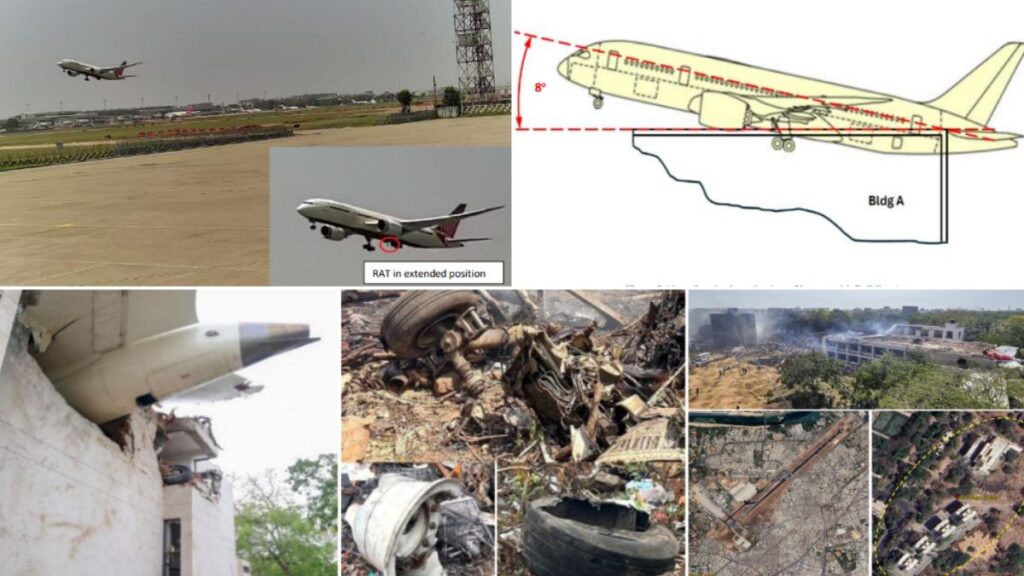Air India AI171 Crash: Preliminary Report Out | Engine Shutdown, Power Loss, and Failed Recovery Lead to Fatal Ahmedabad Tragedy

New Delhi, July 12, 2025: The preliminary report by the Aircraft Accident Investigation Bureau (AAIB) on the Air India flight AI171 crash has revealed a cascade of technical failures and emergency recovery attempts before the aircraft fatally crashed in Ahmedabad on 12 June 2025. The report provides a timeline of cockpit activity, systems malfunction, and failed relight attempts, alongside ongoing forensic and aeromedical investigations.
Tragic Loss of Life and Property
The accident involved an Air India Boeing 787-8 Dreamliner (VT-ANB), which crashed shortly after takeoff from Runway 23 at Ahmedabad. The crash resulted in 260 fatalities, including 12 crew members, 229 passengers, and 19 people on the ground. One passenger and 67 others sustained serious injuries. The aircraft also caused severe structural and fire damage to five buildings, including the BJ Medical College hostel, located just 0.9 nautical miles from the runway end.

Timeline of Events: Sudden Shutdown and Failed Recovery
According to data from the Enhanced Air Flight Recorder (EAFR), the aircraft began a normal takeoff sequence, achieving liftoff at 08:08:39 UTC and reaching a maximum airspeed of 180 knots by 08:08:42 UTC. However, just seconds later, both engine fuel cutoff switches transitioned from RUN to CUTOFF, without any recorded cockpit command, triggering a total power loss.
In the Cockpit Voice Recorder (CVR), one pilot asks, “Why did you cutoff?”, to which the other replies, “I didn’t do so.” The cause of this uncommanded fuel cutoff remains under investigation.
By 08:08:47 UTC, both engines’ N2 values had fallen below minimum idle speed, activating the Ram Air Turbine (RAT), which deployed and began supplying emergency hydraulic power—a strong indicator of onboard power failure.
Emergency Restart Attempts: Too Late to Save the Flight
The aircraft’s systems attempted recovery:
- Engine 1’s fuel switch transitioned back to RUN at 08:08:52 UTC
- The Auxiliary Power Unit (APU) began auto-start at 08:08:54 UTC
- Engine 2’s fuel switch followed at 08:08:56 UTC
As per Boeing’s FADEC (Full Authority Digital Engine Control) protocol, the engines automatically attempted relight. The Exhaust Gas Temperatures (EGT) showed signs of ignition:
- Engine 1 stabilized and showed signs of thrust recovery
- Engine 2, however, failed to maintain core speed and underwent multiple fuel re-introduction attempts, failing to recover completely
Despite these efforts, the aircraft continued to descend.

At 08:09:05 UTC, the pilot issued a “MAYDAY MAYDAY MAYDAY” distress call. The Air Traffic Controller (ATCO) acknowledged but received no further communication. Moments later, the aircraft crashed just beyond the airport perimeter. The EAFR stopped recording at 08:09:11 UTC.

Rescue Response and On-Site Actions
The Crash Fire Tender (CFT) departed the airport at 08:14:44 UTC and was supported by local firefighting and rescue teams. Rescue operations began swiftly, given the crash site’s proximity to the airport.

Subsequent drone photography and videography of the crash site have been completed. The wreckage has been relocated to a secure area within the airport for further analysis. The engines have been quarantined, and specific components of interest have been isolated for detailed inspection.
Fuel Samples and Laboratory Tests
- Fuel from airport bowsers and storage tanks was tested at the DGCA lab and found to be within quality standards
- Minimal fuel retrieved from the APU filter and refuel valve of the left wing will undergo further testing at specialized facilities due to the small sample volume

Investigation Status and Next Steps
The AAIB confirms that:
- The EAFR data from the forward unit is under in-depth analysis
- Witness and survivor statements have been collected
- Postmortem reports are being evaluated to align aeromedical evidence with mechanical findings
- No immediate airworthiness directives have been issued for the Boeing 787-8 or GE GEnx-1B engines
- Investigation is ongoing with additional records and stakeholder data being pursued
In Simple Words
On June 12, 2025, Air India flight AI171, a Boeing 787-8, crashed shortly after taking off from Ahmedabad, killing 260 people, including passengers, crew, and people on the ground. The aircraft lifted off normally, but just seconds later, both engines suddenly shut down because their fuel supply was cut off—though the pilots didn’t command it. One pilot was even heard asking the other why it happened. The aircraft lost power and began falling rapidly. Emergency systems kicked in, and the crew tried to restart the engines. One engine started to recover, but the other failed to regain power in time. The plane crashed into nearby buildings before it could return to the airport. The cause of the fuel cutoff is still under investigation, and no mechanical or bird-related issues have been confirmed yet.
Final Thoughts
The Air India AI171 crash appears to have resulted from an unexpected and unexplained dual engine shutdown, followed by an urgent but unsuccessful recovery sequence. The report offers crucial insights into onboard systems behavior and emergency response, though it stops short of assigning blame or definitive causes.
The aviation community now awaits the final AAIB report, which may recommend changes in flight deck procedures, aircraft automation checks, or emergency protocol enhancements.
Note: All information presented in the above article is based on the Preliminary Report of the accident involving Air India’s B787-8 aircraft (VT-ANB) at Ahmedabad on 12 June 2025, issued by the Government of India, Ministry of Civil Aviation, Aircraft Accident Investigation Bureau. The full report can be accessed here.









